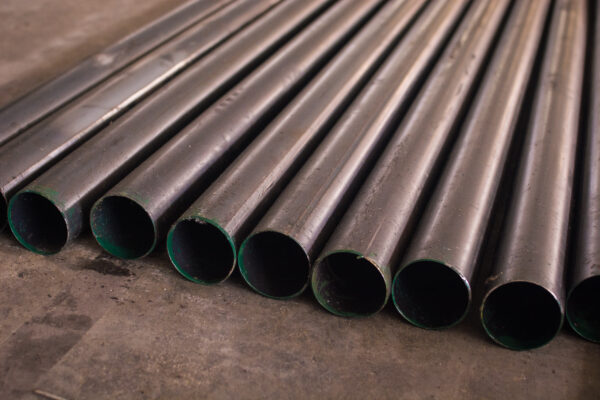What is Mild Steel Used For?
What is mild steel?
Mild steel is the commercial name for low-carbon steel. Mild steel contains about 0.04 to 0.3 percent of carbon. It is a ferrous metal made from iron ore and an allotrope of carbon called coal. There are different grades of mild steel, but anything containing more than 0.3 percent of carbon is either medium-carbon steel or high-carbon steel. It is soft, cheap, ductile and easy to weld. Other elements are usually added to improve its properties, like tensile strength and corrosion resistance.
How mild steel is made?
It is manufactured with the use of a blast furnace. Iron ore and coal are extracted from the earth as the primary raw materials. They are then heated in a blast furnace and like is added as a flux for both materials. Once it is melted, the impurities are then removed, and other alloying elements are then added. The mild steel is then poured into a mould to take shape and solidify. This step is called the casting process.
The product obtained is then taken through a process called hot rolling. After this, the slab of mild steel is then cut into the desired sizes and shapes, like slabs and billets. Thereafter, secondary forming processes like cold rolling and coating give it the final shape and properties. Since the major property of mild steel is iron, it has the tendency to rust easily due to corrosion. Mild steel is usually then coated with another element, such as chromium or titanium but more commonly, zinc, to prevent this.
Physical properties of mild steel
Most of the physical properties of mild steel influence its use in industry. Some of these properties include:
- Ductility: Mild steel can be deformed and reshaped without losing its hardness which makes it long-lasting, economical and reusable.
- Magnetism: Due to the high amount of iron present in mild steel, it exhibits the property of magnetism.
- Machinable: This is due to the low amounts of carbon in mild steel. The lower the amount of carbon, the more malleable it becomes because carbon acts as a barrier to dislocation movement. The ductile nature of mild steel makes it weldable and suitable for various steel fabrication processes.
Chemical properties of mild steel
More importantly, the chemical properties of mild steel influence its frequency of use in everyday life and in industrial use. By the addition of some alloying elements, both the physical and chemical properties can be improved.
One such property is oxidation. Mild steel is prone to oxidation when exposed to the environment, so it is usually further coated with an element such as chromium to prevent rusting. Rusting destroys the steel. Chromium is a popular alloy for coating mild steel because of its reaction with oxygen in the air to form chromium oxide. Chromium oxide protects the steel from further corrosion.
Uses of mild steel
Mild steel is used to create products for use in many industries and markets. It is one of the most popularly used types of steel. It can be used in building construction, pipeline construction, automobile and machinery building, gating and fencing and cookware. From our everyday lives to industry use, mild steel is employed.
Mild steel for building construction
It is highly favoured in building construction as a building frame material, owing to its high tensile strength and malleability. Mild steel can be joined easily, and it can support heavy weights. As required in building construction, mild steel is not easily susceptible to damage. It can withstand damage by insects, rot and fire, and it also meets seismic and winds requirements.
Additionally, it is cheaper and more economical than other forms of steel. It is used in building both small and large structures.
Mild steel in pipeline construction
Due to its excellent ductility, mild steel can be used to create pipelines for transport. It is easily ductile and malleable to create steel pipes, but it is also difficult to break under pressure. Alloyed low-carbon steel also does not react with the possible contents of the pipeline, such as water, oil and even beer. This makes it a suitable material for pipeline transport. The pipes may shrink in cold weather, so they are insulated in order to maintain their performance and durability.
Using low-carbon steel for automobile and machinery building
In this area of use, low-carbon steel is preferred for its malleability. As opposed to spending long hours in welding and shaping when using higher carbon steels, mild steel requires little shaping and sizing after being hot rolled. It also provides good physical attributes. They are then used in producing frames, linings and panels.
Cookware
Mild steel has been proven to stay sharper longer, so it has been employed in the production of knives. It is now more commonly preferred by chefs. This can also be attributed to its higher temperature threshold as opposed to the more commonly stainless steel. Low-carbon steel can also be modified to become non-stick cookware.
While mild steel is more prone to corrosion and damage than stainless steel, this can be overcome by seasoning the metal.
Visually aesthetic fencing and gating
This is also a factor of malleability. It can easily be shaped and bent into different shapes to create beautiful designs for gates. It can also be painted and bears little risk of damage and deformity because of its high tensile strength.
Why mild steel is used in construction?
Strength: The characteristic of Mild steel means that it is strong enough to support structural loads such as those found in buildings. This makes mild steel suitable for use in plates, brackets, and beams.
Cost: Mild steel is relatively affordable. Especially when it’s compared to other building materials like stainless steel or other high-strength alloy metals. It is therefore a brilliant option for construction projects working on a budget.
Easy to work with: Mild steel is simple to fabricate, cut, weld, and form, making it perfect for construction’s need to create any structural elements to design specifications.
What is another name for low carbon steel?
An alternative name for low carbon steel, is mild steel. Low carbon steel, as the name suggests, contains a small percentage of carbon when compared to other steel types. The low amount of carbon make it malleable and easy to work with in a range of different situations in construction, such as manufacturing and fabrication.
What’s the difference between Steel and Mild Steel?
The main difference is in the composition of the steels and their carbon content, let’s examine the differences between these types of steel.
| Characteristic | Steel | Mild Steel |
| Carbon Content | Variable, can range from low to high | Low, typically 0.05% to 0.25% |
| Strength | Varies depending on composition | Lower strength and hardness |
| Malleability | Varies depending on composition | Highly malleable |
| Weldability | Varies depending on composition | Well-suited for welding |
| Uses | Wide range, including construction, automotive, aerospace, tools, etc. | Commonly used in construction, car bodies, pipes, and household appliances |
| Resistance to Corrosion | Varies; some types may be prone to corrosion | Less resistant to corrosion; may require coating or protection to prevent rusting |
Natalie is the content writer for South West Steel Supplies and enjoys updating our blog with new updates and information about steel.




